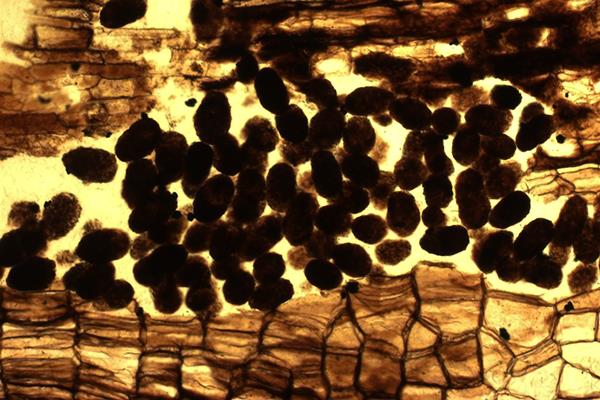Exceptional Permineralized Biotas – Windows into the Evolution and Functional Diversity of Terrestrial Ecosystems Through Time

Invertebrate coprolites in a 220 million-year-old bennettite root from Hopen, Svalbard archipelago.
Summary
This project will utilize large and unique museum collections of exquisite, three-dimensionally preserved plants and associated invertebrates, fungi and micro-organisms entombed in silicified peats, hot-spring cherts and equivalent deposits to clarify the temporal and evolutionary patterns in the development of a range of key biological interactions that are important for the functioning of terrestrial ecosystems.
Using cutting-edge microscopy and tomography techniques, this project will investigate the remarkable three-dimensionally preserved anatomy of fungi, invertebrates and plants within unique organic accumulations permineralized by silica and calcium-carbonate and entombed in leech hirudoin secretions. Using these techniques, details down to the level of cell nuclei, organelles and even individual chromosomes can now be resolved.
Anatomical data obtained from reproductive structures preserved in these deposits will contribute to an improved understanding of the evolutionary history and reproductive biology of a range of seed- and spore-producing plants and fungi.
Investigation of linkages between the entombed organisms will provide unparalleled insights into the evolution of cryptic land biotas through time and shed light on the development of biological interactions, such as mycorrhizal symbioses, saprotrophism, parasitism, mutualism, herbivory and reproduction, that are key to nutrient and energy cycling in terrestrial ecosystems.
This research is funded by the Swedish Research Council (VR)
Project Participants at the Museum
External Project Participants
University of Münster, Germany
Natural History Museum, London, UK
Selected Publications
McLoughlin, S., Bomfleur, B. & Drinnan, A.N., 2018. Pachytestopsis tayloriorum gen. et sp. nov., an anatomically preserved glossopterid seed from the Lopingian of Queensland, Australia. Transformative Paleobotany: Papers to Commemorate the Life and Legacy of Thomas N. Taylor. Krings, M., Harper, C.J., Cúneo, N.R., Rothwell, G.W. (eds), Elsevier, Amsterdam, 155-178. ISBN: 9780128130124
Bomfleur, B., Blomenkemper, P., Kerp, H. & McLoughlin, S. 2018. Polar regions of the Mesozoic–Paleogene greenhouse world as refugia for relict plant groups. Transformative Paleobotany: Papers to Commemorate the Life and Legacy of Thomas N. Taylor. Krings, M., Harper, C.J., Cúneo, N.R., Rothwell, G.W. (eds), Elsevier, Amsterdam, 593-611. ISBN: 9780128130124
McLoughlin, S. & Pott, C., 2018. Plant mobility in the Mesozoic: disseminule dispersal strategies of Chinese and Australian Middle Jurassic to Early Cretaceous plants. Palaeogeography, Palaeoecology, Palaeogeography. https://doi.org/10.1016/j.palaeo.2017.12.036
McLoughlin, S., Pott, C. & Sobbe, I., 2018. The diversity of Australian Mesozoic bennettitopsid reproductive organs. Palaeobiodiversity and Palaeoenvironments 98: 71-95. DOI: https://doi.org/10.1007/s12549-017-0286-z
Bomfleur, B., Grimm, G.W., McLoughlin, S., 2017. The fossil Osmundales (Royal Ferns)—a phylogenetic network analysis, revised taxonomy, and evolutionary classification of anatomically preserved trunks and rhizomes. PeerJ 5, e3433. doi: 10.7717/peerj.3433 .
.
Vajda, V., Pucetaite, M., McLoughlin, S., Engdahl, A., Heimdal, J., and Uvdal, P. 2017. Molecular signatures of fossil leaves provide unexpected new evidence for extinct plant relationships. Nature Ecology and Evolution 1: 1093-1099. DOI: 10.1038/s41559-017-0224-5
McLoughlin, S., Bomfleur, B., Mörs, T., 2016. The weird world of fossil worm cocoons. Deposits Magazine 46, 15–17.
McLoughlin, S., 2016. Exceptional fossils and biotas of Gondwana: the fortieth anniversary issue of Alcheringa. Alcheringa 40, 399–406.
McLoughlin, S. & Strullu-Derrien, C., 2016. Biota and palaeoenvironment of a high middle-latitude Late Triassic peat-forming ecosystem from Hopen, Svalbard Archipelago. In Kear, B. P., Lindgren, J., Hurum, J. H., Milàn, J. & Vajda, V., eds, Mesozoic Biotas of Scandinavia and its Arctic Territories. Geological Society of London Special Publications 434: 87–112.
McLoughlin, S. & Bomfleur, B. 2016. Biotic interactions in an exceptionally well preserved osmundaceous fern rhizome from the Early Jurassic of Sweden. Palaeogeography, Palaeoclimatology, Palaeoecology 464: 86–96.
McLoughlin, S., Bomfleur, B., Mörs, T. & Reguero, M., 2016. Fossil clitellate annelid cocoons and their microbiological inclusions from the Eocene of Seymour Island, Antarctica. Palaeontologia Electronica 19.1.11A.
Vajda, V., Linderson, H. & McLoughlin, S., 2016. Disrupted vegetation as a response to Jurassic volcanism in southern Sweden. In: Kear, B. P., Lindgren, J., Hurum, J. H., Milàn, J. & Vajda, V. (eds) Mesozoic Biotas of Scandinavia and its Arctic Territories. Geological Society, London, Special Publications, 434: 127–147.
Haig, D. Martin, S.K., Mory, A.J., McLoughlin, S., Backhouse, J., Berrell, R.W., Kear, B.P., Hall, R., Foster, C.B., Shi, G.R., Bevan, J.C., 2015. Early Triassic (early Olenekian) life in the interior of East Gondwana: mixed marine-terrestrial biota from the Kockatea Shale, Western Australia. Palaeogeography, Palaeoclimatology, Palaeoecology 471: 511–533.
McLoughlin, S., Martin, S.K. & Beattie, R., 2015. The record of Australian Jurassic plant-arthropod interactions. Gondwana Research 27: 940–959.
Slater, B.J., McLoughlin, S. & Hilton, J., 2015. A high-latitude Gondwanan lagerstätte: The Permian permineralised peat biota of the Prince Charles Mountains, Antarctica. Gondwana Research 27: 1446–1473.
McLoughlin, S., Drinnan, A.N., Slater, B.J. & Hilton, J., 2015. Paurodendron stellatum: a new Permian permineralized herbaceous lycopsid from the Prince Charles Mountains, Antarctica. Review of Palaeobotany and Palynology 220: 1–15.
Bomfleur, B., Grimm, G.W. & McLoughlin, S., 2015. Osmunda pulchella sp. nov. from the Jurassic of Sweden--reconciling molecular and fossil evidence in the phylogeny of modern royal ferns (Osmundaceae). BMC Evolutionary Biology 15:126, (25 pp.).
Bomfleur, B., Mors, T., Ferraguti, M., Reguero, M.A. & McLoughlin, S., 2015. Fossilized spermatozoa preserved in a 50-myr-old annelid cocoon from Antarctica. Biology Letters 11, 20150431.


